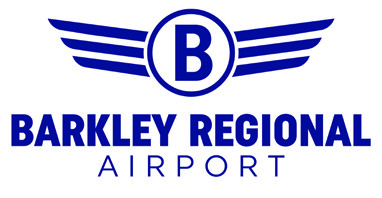Barkley Regional Airport (PAH) in West Paducah, KY, completed a curb-to-tarmac transformation. In addition to building a new terminal, the airport constructed a new entrance road, brought in brand-new utilities, added new parking facilities and built a new terminal apron with a passenger boarding bridge.
This June, Barkley Regional Airport (PAH) in West Paducah, KY, completed a curb-to-tarmac transformation. In addition to building a new terminal, the airport constructed a new entrance road, brought in brand-new utilities, added new parking facilities and built a new terminal apron with a passenger boarding bridge. Its newly constructed 26,000-square-foot terminal is more than twice the size of the facility it replaced and is filled with updated features such as ADA-compliant restrooms, a more advanced baggage handling system and upgraded security. Moreover, all passengers now board through an enclosed jet bridge rather than outside from the ramp.
 Airport Executive Director Dennis Rouleau explains that PAH’s previous terminal was more than 65 years old and was proving costly to maintain. Its boiler system had failed twice, there was asbestos in some parts of the building, and the several dated HVAC units needed frequent repair. In 2011, Barkley Regional Airport Authority (BRAA) commissioned a terminal siting and footprint study.
Airport Executive Director Dennis Rouleau explains that PAH’s previous terminal was more than 65 years old and was proving costly to maintain. Its boiler system had failed twice, there was asbestos in some parts of the building, and the several dated HVAC units needed frequent repair. In 2011, Barkley Regional Airport Authority (BRAA) commissioned a terminal siting and footprint study.
Atkins, the firm that conducted the study, recommended building a new terminal on a greenfield site in the south-central portion of the airport’s property. In 2018, BRAA validated the 2011 study to confirm the proposed terminal size and update estimated costs. The Authority Board of Directors then pushed to develop and provide a concept layout plan to issue a request of proposals to select a consultant.
|
Project: New Terminal Location: Barkley Regional Airport— West Paducah, KY Terminal Size: 26,000 sq. ft. Approx. Cost: $43.5 million Funding: $20 million in FAA AIP Terminal Discretionary Grants; $10.8 million in FAA AIP Airside Discretionary & Entitlements Grants; $850,000 from CARES Act (via FAA AIP); $1.15 million from American Rescue Plan Act (via FAA AIP); $5 million from Kentucky Dept. of Aviation; $5.7 million combined from city of Paducah & McCracken County; $80,000 from Paducah Area Community Reuse Organization Construction: Nov. 2020–June 2023 Key Components: ADA-compliant features; mothers’ room & family restrooms; upgraded security systems; private TSA screening room; TSA on-site office space; digital monitors; automated baggage handling system; passenger boarding bridge; passenger, employee & car rental parking lots; new entrance road; new terminal apron Lead Aviation Planner & Architect: Alliiance Local Architectural Partner: PFGW Terminal Building General Contractor: MP Lawson Construction Inc. Site Improvements General Contractor: Jim Smith Contracting Co. LLC Civil Engineering, Grant Administration & Budgeting Support: CHA Consulting Inc. Site Survey & Geotechnical Investigation: American Engineers Inc. Structural Engineering: BFW Engineering & Testing Inc. Electrical Engineering: Marcum Engineering LLC Art Consultant: Via Partnership Telecom & Security: Faith Group Full-Body CT Scanner: Analogic Baggage Handling System & Passenger Boarding Bridge Engineering: Swanson Rink Passenger Boarding Bridge: JBT Automated Baggage Handling System: ASI Seating: Arconas; Martin Brattrud; Davis; Keilhauer Wayfinding: Entro Terminal Siting & Footprint Study: Atkins Key Benefits: Improved passenger experience & operational efficiencies; room for expansion & increased capacity |
Alliiance was selected as the lead planner and prime architect, with local assistance provided by PFGW Architects. CHA Consulting was selected for civil engineering services and also provided grant administration and budgeting assistance. MP Lawson Construction built the terminal, and Jim Smith Contracting performed site work and paved access roads, an airside apron and a new parking lot for passengers, employees and rental cars.
The approximate $43.5 million project was funded through several sources:
- $20 million in FAA Airport Improvement Program (AIP) Terminal Discretionary Grants,
- $10.8 million in FAA AIP Airside Discretionary and Entitlements Grants,
- $850,000 from the CARES Act (via FAA AIP),
- $1.15 million from the American Rescue Plan Act (via FAA AIP),
- $5 million from the Kentucky Department of Aviation,
- $5.7 million combined from the city of Paducah and McCracken County, and
- $80,000 from the Paducah Area Community Reuse Organization.
“In the end, we were successful at getting all the funding in line,” says Rouleau.
Before design work began, BRAA created a passenger experience committee with community leaders, elected officials and other high-profile individuals who had a stake in the new terminal. Using a visioning process to discuss local influences to consider, the committee determined it wanted the terminal to have a front-porch feeling. “Kentucky is all about front porches and being neighborly,” Rouleau explains, noting that the airport acts as the front door to the Western Kentucky region. “It’s going to make a statement that Western Kentucky is very welcoming, but it’s also sophisticated.”
Project Prep
CHA performed earthwork grading and drainage design for the greenfield site and also brought in utilities and modern communication systems. “It was designed to be effective for many, many more years to come and has all the latest and greatest modern amenities in the building and on the site,” remarks Brian McReynolds, vice president of operations with Jim Smith Contracting.
In November 2020, crews began clearing the ground and demolishing small storage buildings that were on the site. They also relocated a National Weather Service Automated Surface Observing Systems station to the opposite side of the airfield.
New Terminal, New Features
A 10-foot overhang shields travelers entering and exiting the new building. “The influence of historical Paducah is visible in the brick paver-lined drop-off sidewalk, natural stone façade and expressive porch-like roof that welcomes travelers,” remarks Michael McClimon, senior associate and project designer with Alliiance. The terminal exterior is a combination of metal shake siding, natural stone and timber. Outdoor seating provides a park-like setting for guests who want to pause and rest.
 Architects also included ornamental features, landscaped entry walls and signage with limestone veneer. “It’s a very well-designed building from an aesthetics perspective, and I think the functionality is equally as good,” says McReynolds.
Architects also included ornamental features, landscaped entry walls and signage with limestone veneer. “It’s a very well-designed building from an aesthetics perspective, and I think the functionality is equally as good,” says McReynolds.
Alliiance worked to create an intimate, easy-to-use facility with state-of-the-art amenities and accommodations. Designers also placed an emphasis on providing hospitality and meeting the needs of both leisure and business passengers. The new ticket counters they specified in the lobby create the feel of a boutique hotel—a far cry from the former space some jokingly compared to an old bus station. “Now, it’s a very beautiful facility,” says Rouleau.
Airport guests are enjoying many features that did not exist in the previous terminal, including a mothers’ room, family restrooms and ADA-compliant counters, tables and more. Passengers especially appreciate the new JBT boarding bridge during inclement weather. “The whole goal of the project was to enhance the passenger experience,” Rouleau summarizes. The automated baggage handling system from ASI is far more advanced than its predecessor, which expedites baggage handling and screening for passengers and employees alike.
A variety of more comfortable seating options with built-in power is available throughout the terminal. “Everything’s going to have power,” Rouleau says, noting that powered tabletops are available at multiple heights, including lower tables for easy access from wheelchairs. Near the gates, travelers can use privacy cubbies to work on laptops. The airport also installed club seating and updated versions of traditional holdroom seating.
The new parking lot offers 200 parking spaces for guests, with room for 200+ more in the future. The rental car parking lot has 50 spaces and has room for at least 50 more. The airport’s 6,500-foot asphalt runway did not need to be replaced at the time, but BRAA added a new apron and a new connector to the parallel taxiway. The runway is slated for improvement next year.
Security and Tech Improvements
Major security upgrades include the addition of a private screening room for travelers at the TSA checkpoint, keycard access (vs. metal keys) for employees, and on-site TSA offices. The explosives detection system TSA purchased in 2022 was moved from the old terminal into a dedicated baggage screening room away from the public in the new terminal. The airport is also getting an Analogic full-body scanner this October.
Technology improvements include two IT rooms with purpose-built HVAC cooling systems, a more sophisticated paging system with multiple zones, a new security system and digital monitors for advertising. The new security camera system includes higher-quality (and more) cameras than the former terminal had. A few years ago, a semi-truck drove into the old terminal building, ripping out power lines and causing thousands of dollars of damage. “We couldn’t read the license plate with the new cameras we had just installed,” Rouleau laments. “Now, we have cameras that can.” The new terminal also has a fiber line going to the firehouse so aircraft rescue and firefighting staff there can view security camera footage as well.
Previously, PAH had wall-mounted display cases in the terminal for large-format print advertising, but the new building features digital monitors. The change will allow BRAA to sell more ads at a lower per-ad price, creating the potential to generate more total revenue. “We’ll have opportunities to do some cool things, like sell ads to customers to welcome home friends or relatives by name,” Rouleau says. “We can put that on the monitors and personalize it.” BRAA also partnered with the Paducah Convention and Visitors Bureau to install a video wall in the baggage claim area that is used for advertising and welcoming guests to the community as well.
Efficiency Boost
The Airport Authority did not pursue certification from the U.S. Green Building Council for the new terminal, as the team was already concerned about cost. “We had cut back the size of the terminal to stay within the $20 million FAA cap for the terminal building itself [for non-hub primary airports],” Rouleau notes. “We wanted the terminal to be as efficient as possible, but we didn’t think it was financially necessary to seek LEED certification.”
Regardless, the terminal was built with many energy-efficient features. New lighting, heating and air-conditioning systems are expected to save the Airport Authority a considerable amount of money in lower utility bills.
All interior and exterior lighting fixtures have LED bulbs and programmable timers. During flight times, lighting levels automatically increase as needed depending on the time of day and available natural light. At night, lights dim to 10% brightness. Passive design strategies were embedded in the form of the building to maximize natural daylight while shading the glass from intense summer sun. The HVAC system is also programmable, providing further efficiency and cost savings. All bathroom fixtures at PAH have low-flow plumbing as well.
Built for Expansion
 The new terminal currently has two gates with one passenger boarding bridge, but the building and surrounding infrastructure were designed with future expansion in mind. CHA included a second aircraft parking stand for ground boarding now and also made provisions for a future second taxiway connector on the southwest side of the apron that can be added when PAH has a busier flight schedule. The team also planned for other airfield developments in case the airport wants to relocate facilities (perhaps the fire station or a maintenance facility) closer to the new terminal. “We did some concept layouts, so they wouldn’t necessarily be space-constrained around the immediate terminal area,” says Jamin Heldt, CHA project manager. Planners also accounted for the ability to accept future development around the terminal complex in the stormwater hydrology and hydraulic design.
The new terminal currently has two gates with one passenger boarding bridge, but the building and surrounding infrastructure were designed with future expansion in mind. CHA included a second aircraft parking stand for ground boarding now and also made provisions for a future second taxiway connector on the southwest side of the apron that can be added when PAH has a busier flight schedule. The team also planned for other airfield developments in case the airport wants to relocate facilities (perhaps the fire station or a maintenance facility) closer to the new terminal. “We did some concept layouts, so they wouldn’t necessarily be space-constrained around the immediate terminal area,” says Jamin Heldt, CHA project manager. Planners also accounted for the ability to accept future development around the terminal complex in the stormwater hydrology and hydraulic design.
Currently, PAH has one carrier, Contour Airlines, and typically just one flight coming or going at any particular time. However, the terminal was designed with room to expand the apron and holdroom area. The airport has had more than one airline in the past, and BRAA hopes to add another carrier in the future. “We think we’re poised very well to attract an ultra-low-cost carrier,” Rouleau notes. “This is a terminal not only for today, but for tomorrow.”
The “Wow” Factor
Knowing it wanted attractive artwork in the new terminal, BRAA created an ad-hoc art committee from the Barkley Regional Airport Board to assist the search and selection process. The committee worked in collaboration with Via Partnership, a public art consulting firm, to solicit proposals from artists who currently live or previously lived within 50 miles of the airport. Emphasis was placed on procuring pieces that highlight the region’s people, places, ecology, culture, heritage, celebrated places and/or experiences.
 “The goals were to provide an impactful ‘wow’ experience to welcome people to Paducah and the region, generate community pride through high-quality works of art, and highlight aspects of Paducah’s art and culture that it has become known for worldwide,” says April Meyer, a principal at Alliiance.
“The goals were to provide an impactful ‘wow’ experience to welcome people to Paducah and the region, generate community pride through high-quality works of art, and highlight aspects of Paducah’s art and culture that it has become known for worldwide,” says April Meyer, a principal at Alliiance.
The carefully crafted process yielded three major pieces of artwork: Flight Pattern Quilt, by Louisville native Guy Kemper, is a 29-foot-long mosaic of smalti glass that represents Paducah’s prominence in fabric quilting. Angles Garden, by Paducah resident Nikki May, is a tribute to the airport’s namesake, Alben Barkley, former U.S. vice president under Harry S. Truman. May’s illustrated garden of regional flora and fauna was installed by a window contractor on the glass wall that separates the security checkpoint and gate area. While some areas of the piece allow light to stream in through from both sides, specific portions are opaque to meet TSA privacy requirements. Kaleidoscopes of Paducah, by local photographer Russel Bash, depicts the city’s landmark buildings in intricate polygons. The collection is displayed in a frame built out of a cornice piece salvaged from a historic Paducah bank.

“This terminal definitely has a ‘wow’ factor,” Rouleau says. “They say this is the nicest building in Western Kentucky.”
Overcoming Challenges
During the early design stage, BRAA personnel planned to tour several new airports for ideas and inspiration. But then COVID hit, and they had to proceed remotely. “Even the visioning process with the architects was a challenge, but I think they did a great job,” Rouleau recalls.
The pandemic also created labor shortages and supply chain issues. Then, weather delayed some of the site work. As a result, the original completion target of March 2023 slipped by about 60 days.
Although the pandemic created challenges for the design and construction teams, it also provided COVID relief funding through the CARES and American Rescue Plan Acts. As a result, less money was needed from the community to support the new terminal.
Airport Authority leaders worked to finalize funding while the site design was in progress and the project scope was being finalized. They also collaborated with CHA to strategically structure bid packages based on eligibility for federal funding, especially since FAA was matching grants at 100% in fiscal year 2020 and 2021 via the CARES and American Rescue Plan Acts. From the very beginning, the guiding principle was to leverage every federal dollar that was available. Heldt notes that it was important to advise project stakeholders about funding nuances—why certain aspects were eligible and others weren’t—because smaller airports like PAH don’t have the operating budget to staff their own specialized accounting departments or hire capital development specialists.
“It was a challenging piece of the program to keep all of those different funding buckets separate and make sure everybody was up to speed on where things stood and why,” Heldt adds. “Communication was key.”
 At the project site, silty soil presented challenges for Jim Smith Contracting. “The characteristics of the soil were difficult for building and ended up requiring the use of chemical stabilization methods to support the pavements and even support the building foundation,” McReynolds explains.
At the project site, silty soil presented challenges for Jim Smith Contracting. “The characteristics of the soil were difficult for building and ended up requiring the use of chemical stabilization methods to support the pavements and even support the building foundation,” McReynolds explains.
Managing stormwater was difficult because the flat construction site receives significant drainage from surrounding off-airport areas. Water enters the site and then exits across the airfield through different pathways. “It was challenging to try to make improvements without breaking the bank and to make sure the site was going to drain well and not be a maintenance challenge for the airport going forward,” says Heldt.

Lessons Learned
For other airports building a new terminal or upgrading existing facilities, Heldt suggests thoroughly documenting the decision-making process, including goals and objectives, choices made along the way and considerations about financial or physical constraints. “Make sure all the stakeholders understand what the constraints are for the site and then try to stay current on where the budget stands,” he says.
From a design standpoint, Heldt recommends planning for the bare minimum of what is needed, and then, if possible, incrementally adding other elements that stakeholders request. “Document what you want and where you’re going,” he says.
McReynolds emphasizes the importance of understanding and appreciating how each aspect of the project is funded. “We’re very thankful for the people who put effort into getting those grants and chasing those dollars to bring an investment in our community,” he remarks.
Establishing separate bid packages for earthwork/site development and construction helped expedite the overall schedule, McReynolds adds.
 Destin Nygard, a senior associate and project manager with Alliiance, notes that regional airports such as PAH should not be considered any less significant than their larger counterparts, as they play a vital role in connecting communities and facilitating travel for a diverse range of passengers. “These facilities can be state-of-the-art while remaining economical and resilient to changes in the future,” says Nygard.
Destin Nygard, a senior associate and project manager with Alliiance, notes that regional airports such as PAH should not be considered any less significant than their larger counterparts, as they play a vital role in connecting communities and facilitating travel for a diverse range of passengers. “These facilities can be state-of-the-art while remaining economical and resilient to changes in the future,” says Nygard.
Assembling a team that worked well together was crucial for Rouleau. He highlights Alliiance for helping BRAA leaders visualize and weigh their options without visiting other airports while COVID raged. “They figured out a way to make it happen and were brilliant in how they did it,” Rouleau raves.
He also gives top marks to CHA for being “very, very conscientious” and protecting PAH’s interest. “Everybody did a great job,” says Rouleau, noting that local contractors MP Lawson and Jim Smith Contracting had a special stake in the project.
Above all, he credits the Barkley Regional Airport Board of Directors for its forward thinking, and also gives shout-outs to the FAA and its Memphis Airports District Office, TSA, the Department of Transportation, Congressman James Comer, Senator Mitch McConnell, Governor Andy Beshear, Mayor Bray and Judge Executive Clymer and the Paducah Area Chamber of Commerce. “Everyone was very, very supportive of this project, and we’re just extremely grateful for everyone stepping up to the plate,” he remarks. “This is a new day, and we’re very excited for the future.”
Looking Ahead
Although the new terminal is complete, the airport still has several projects in its queue. First up is rehabbing the main runway. Subsequent projects will include renovating the airport-owned FBO, and building a new fuel farm, a new snow removal and equipment facility, a new fire station and new perimeter and access roads.
BRAA has already secured $5.8 million from the commonwealth of Kentucky for federal match to fund a new fuel farm, FBO renovations and sanitary sewer improvements.
Eventually, PAH will tear down its old terminal building to create space for future air cargo development. “This airport needed to move forward to realize its full potential,” Rouleau remarks. “The terminal was the first thing, and we’re not stopping there.”


 facts&figures
facts&figures

